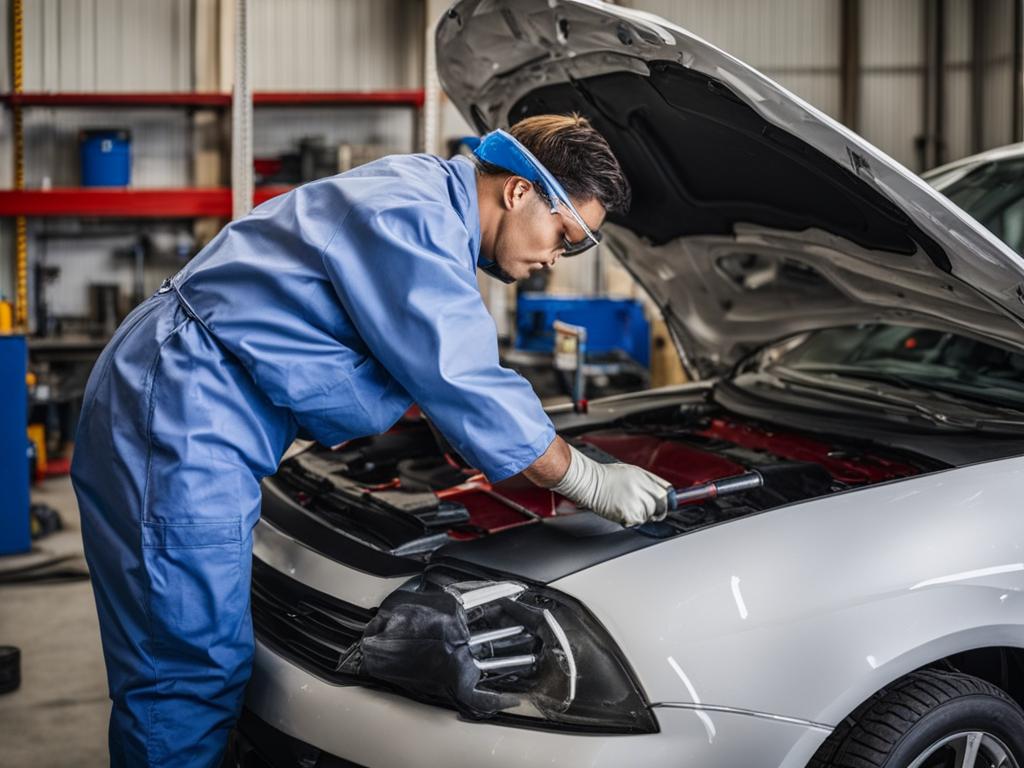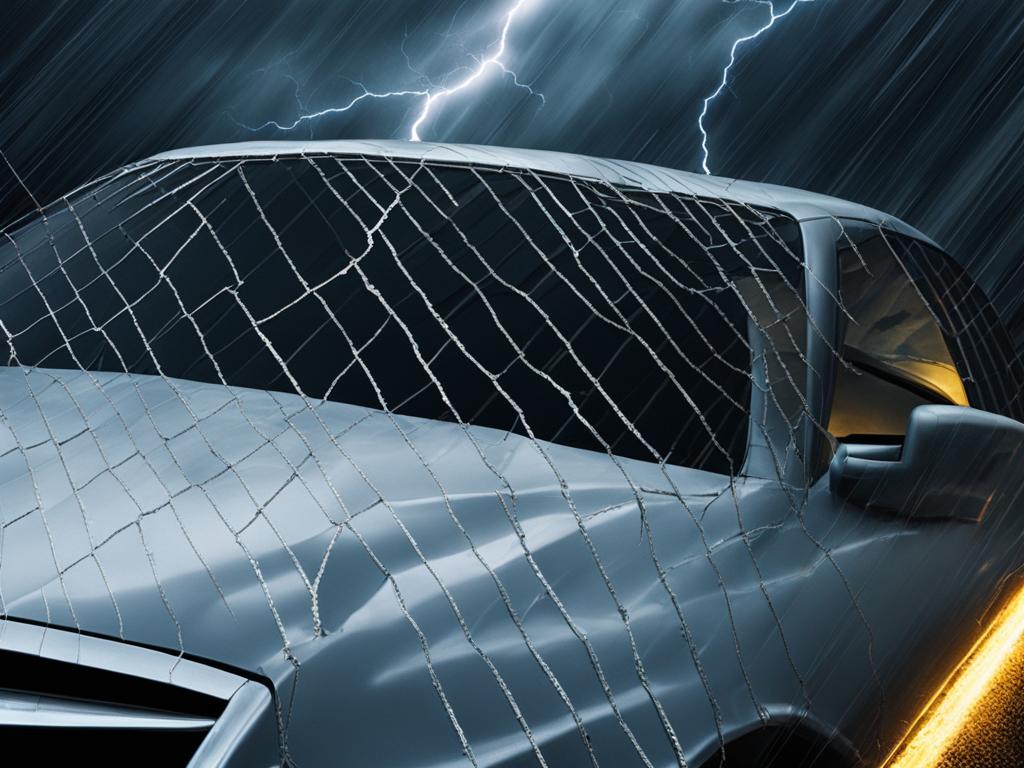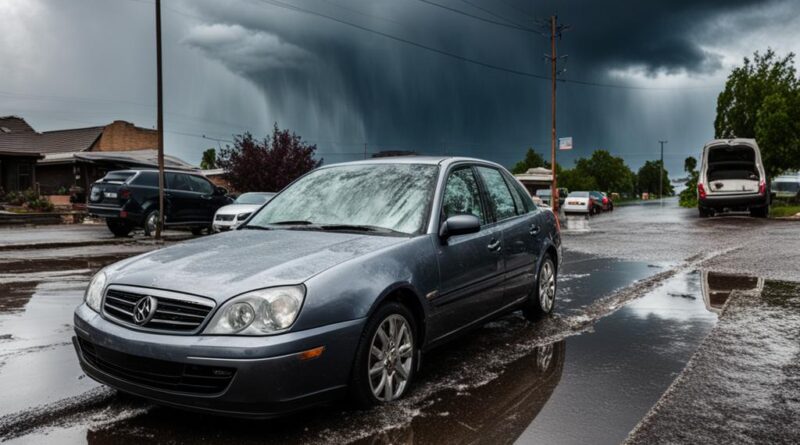Understanding: How Much Does It Cost to Fix Hail Damage?
Each year, hail storms cause significant damage to cars in the United States, resulting in repair costs that vary depending on several factors. Understanding the cost to fix hail damage is crucial before seeking repairs. In this article, we will explore the different types of damage, repair methods, insurance coverage, and factors that affect the overall cost.
Key Takeaways:
- Hail storms cause between $8 billion and $14 billion of damage to cars annually
- The cost to fix hail damage varies depending on the extent of the damage and the repair method used
- Traditional dent repair is a comprehensive and more expensive option
- Paintless dent repair is a cost-effective method for minor hail damage
- Insurance coverage can help offset the cost of hail damage repair
What Sort of Damage Can Hail Cause?
Hail storms can cause significant damage to cars, with various parts of the vehicle being susceptible to harm. The most common type of damage caused by hail is dents and scratched paint. These occur when hailstones strike the car’s exterior, leaving behind visible marks and imperfections. The severity of these dents and scratches can vary depending on the size and force of the hailstones.
In addition to dents and scratched paint, more extreme hail storms can also result in cracked windshields. The impact of large hailstones can cause the glass to fracture or shatter completely. This not only compromises the structural integrity of the windshield but also poses a safety risk for the driver and passengers. Furthermore, if the hail is accompanied by heavy rainfall, water can seep into the interior of the car, leading to potential water damage and mold issues.
It is important to note that the extent of the damage will determine the cost of repair for hail damage. While minor dents and scratches may be relatively easy to fix, more severe damage, such as cracked windshields or water damage, may require more extensive repairs and incur higher costs.
Traditional Dent Repair
Traditional dent repair is a thorough method used to restore a car’s appearance after hail damage. This repair option involves several steps to ensure a comprehensive and long-lasting solution. The process begins by sanding the paint off the damaged area to expose the dents and scratches. Next, skilled technicians use specialized tools to carefully hammer out the dents and reshape the metal back to its original form. This meticulous process requires precision and expertise to ensure the best results.
After the dents are hammered out, any gashes or deep scratches are filled in with putty, creating a smooth surface for repainting. The car is then primed and receives two coats of paint to match the original color. This meticulous approach ensures a seamless repair that is indistinguishable from the car’s original condition.

While traditional dent repair is a thorough option for hail damage repair, it does tend to be more expensive compared to other methods. The labor-intensive nature of hammering out the dents, filling in gashes, and repainting the entire area contributes to the higher cost. However, the result is a meticulously restored car that looks as good as new.
Benefits of Traditional Dent Repair:
- Thorough repair method
- Restores the car’s appearance to its original condition
- Indistinguishable from the car’s original state
Overall, traditional dent repair is an excellent choice for those seeking a comprehensive and high-quality repair for their hail-damaged car. Although it may be more expensive, the thoroughness of this method ensures a long-lasting solution that will leave your car looking as good as new.
Table: Comparison of Hail Damage Repair Methods
| Repair Method | Pros | Cons |
|---|---|---|
| Traditional Dent Repair | Thorough repair, indistinguishable from original condition | More expensive, labor-intensive |
| Paintless Dent Repair | Cost-effective, no need for repainting | Suitable for minor hail damage only |
Paintless Dent Repair
Paintless dent repair, also known as PDR, is a highly effective and cost-efficient method for repairing cosmetic damage caused by minor hail damage. This technique focuses on dent removal without the need for repainting, making it a popular choice among car owners. PDR is suitable for cars with small to medium-sized dents and can restore the smooth and unblemished appearance of the vehicle.
The process of paintless dent repair involves using special tools to carefully massage the dented area from behind, gradually pushing the metal back into its original shape. This method eliminates the need for filling, sanding, and repainting, resulting in a faster and more affordable repair solution. Additionally, the original factory finish of the car is preserved, preventing any mismatched paint or color variations.
Paintless dent repair is highly skilled work that requires expertise and precision. Trained technicians use specialized tools, such as metal rods and dent removal tools, to access the backside of the dented panel and carefully manipulate the metal to its original form. The process can take anywhere from a few minutes to a few hours, depending on the size and complexity of the dent. Overall, paintless dent repair offers a convenient and effective solution for minor hail damage, providing car owners with a cost-effective alternative to traditional dent repair methods.
The Advantages of Paintless Dent Repair:
- Cost-effective: Paintless dent repair is generally less expensive than traditional dent repair, as it eliminates the need for extensive labor and repainting.
- Quick turnaround: Since there is no need for repainting, paintless dent repair can be completed in a shorter amount of time compared to traditional methods.
- Preserved vehicle value: By maintaining the original factory finish, paintless dent repair helps preserve the resale value of the car.
- Eco-friendly: PDR does not involve the use of harsh chemicals or excessive amounts of paint, making it a more environmentally friendly repair option.
Table: Comparing Paintless Dent Repair and Traditional Dent Repair Methods
| Paintless Dent Repair | Traditional Dent Repair | |
|---|---|---|
| Repair Time | Shorter | Longer |
| Cost | Less expensive | More expensive |
| Paint Damage | No damage | May require repainting |
| Vehicle Value | Preserved | May decrease |
| Environmental Impact | Minimal | Higher due to paint and chemicals |
Insurance Coverage
When it comes to repairing hail damage, insurance coverage can play a crucial role in offsetting the costs involved. Comprehensive policies typically cover damage caused by hail storms, providing a financial safety net for car owners. Before filing a claim, it is important to understand the extent of coverage and any limitations that may apply. Consulting with your insurance agent will help clarify the process and ensure that you take full advantage of your policy.
Insurance coverage for hail damage repair can help alleviate the burden of out-of-pocket expenses. With the right coverage, you can significantly reduce the repair costs and make the necessary repairs without breaking the bank. However, it is important to note that insurance coverage may not cover all types of repairs or may require you to pay a deductible before benefits kick in. Understanding the terms and conditions of your policy will help you navigate the claims process with confidence.
When filing an insurance claim for hail damage repair, be prepared to provide documentation such as photographs or repair estimates to support your case. Insurance companies may also require an inspection to assess the extent of the damage and determine the eligibility for coverage. By following the proper procedures and working closely with your insurance provider, you can ensure a smoother process and maximize your insurance coverage to minimize repair costs.

Hail Damage Repair Insurance Coverage Summary
| Insurance Coverage | Comprehensive Policies |
|---|---|
| What’s Covered | Hail damage caused to your car |
| Limitations | May not cover all types of repairs May require a deductible |
| Claims Process | Provide documentation (photos, estimates) Inspection may be required |
| Maximizing Coverage | Understand policy terms and conditions Work closely with your insurance provider |
Out-of-Pocket Costs
The cost to repair hail damage can vary depending on the size and number of dents. On average, repairing small dents can cost between $30 and $45 per dent, while larger dents can cost over $75 each to repair. The total cost of repair can add up quickly, especially if there are multiple dents. On average, hail damage repair costs can exceed $3,000 once all the dents are accounted for.
When determining the out-of-pocket costs for hail damage repair, it is essential to consider the number of dents on the car. Each dent requires individual repair work, including dent removal, filling, and repainting. Therefore, the more dents present, the higher the total repair cost will be. Additionally, the size of the dents also affects the cost, as larger dents may require more extensive repair techniques and materials.
It’s worth noting that the total repair cost can fluctuate based on the labor and material rates charged by the repair shop. Some shops may offer package deals or discounts for repairing multiple dents, so it’s advisable to shop around and compare quotes from different repair shops before making a decision.

Table: Average Repair Costs by Dent Size
| Dent Size | Average Cost |
|---|---|
| Small | $30 – $45 per dent |
| Medium | $50 – $75 per dent |
| Large | $75+ per dent |
As shown in the table above, the average repair costs for hail damage vary based on the size of the dents. Small dents are generally more affordable to repair, while larger dents can significantly increase the overall cost. It’s essential to consult with a reputable repair shop to assess the extent of the damage and receive an accurate estimate for the out-of-pocket expenses.
Ongoing Costs
Even after the hail damage is repaired, there can still be ongoing costs and implications. Depending on the extent of the damage, the cost to repair hail damage may exceed the value of the car. In such cases, the insurance company may declare the car as a total loss. This can impact the resale value of the car and make it difficult to sell at the desired price.
When a car is deemed a total loss, it means that the cost to repair the hail damage is higher than the actual value of the vehicle. This can be a significant financial setback, as the owner may still owe money on a car loan but receive a payout that is less than the remaining balance. Additionally, the car’s resale value may be significantly reduced, as potential buyers may be wary of purchasing a car that has been declared a total loss.
Furthermore, ongoing costs can also be associated with future insurance premiums. If a car has been declared a total loss due to hail damage, it may be classified as a salvaged or rebuilt vehicle. Insurance companies often view these types of vehicles as higher risks, resulting in higher insurance premiums. This can further increase the overall cost of owning a car that has been damaged by hail.

Factors Impacting Car Resale Value after Hail Damage
When a car has experienced hail damage and has been repaired, the resale value can be affected by several factors:
- The severity of the hail damage and the quality of the repair work.
- The age, make, and model of the car.
- The demand for cars in the market at the time of resale.
- The perception of potential buyers regarding the car’s history.
It is important to consider these factors when deciding whether to repair a hail-damaged car or sell it as-is. In some cases, the cost of repairing the damage may outweigh the potential increase in resale value, making it more financially viable to sell the car without repairs.
Factors Affecting Hail Damage Repair Cost
Several factors come into play when determining the cost of hail damage repair. These factors can vary widely and can have a significant impact on the overall repair cost. Let’s take a closer look at some of the key factors:
Dent Size and Number
The size and number of dents on your vehicle will greatly affect the repair cost. Larger dents or a higher number of dents will require more extensive repair work, potentially increasing the overall cost. It’s important to assess the extent of the damage to accurately estimate the repair cost.
Car Year and Model
The year and model of your car can also impact the repair cost. Newer and high-end vehicles often have specialized materials or construction that make repairs more complex and expensive. Additionally, certain models may require specific parts that are more costly to replace. It’s important to consider the specific characteristics of your car when estimating repair costs.
Insurance Coverage
The extent of your insurance coverage will also play a role in the out-of-pocket repair cost. If you have comprehensive coverage, your insurance may cover a portion or the entire cost of hail damage repair. However, it’s important to review your policy and understand the coverage limits and deductibles to determine your potential out-of-pocket expenses.
By considering these factors, you can get a better understanding of the potential repair cost for hail damage on your vehicle. It’s important to assess the damage accurately and consult with a reputable repair shop to get an estimate tailored to your specific situation.

Hail Damage Repair Cost Examples
Understanding the potential cost of hail damage repair can help you prepare financially for any unexpected repairs. The cost of hail damage repair can vary greatly depending on the severity of the damage. Here are some examples to give you an idea of what to expect:
Light Hail Damage:
For cars with light hail damage, which typically includes small dents and minimal paint scratches, the repair cost can range from $4,000 to $10,000. This price range covers the expenses for dent removal and minor paint touch-ups.
Severe Hail Damage:
If your car has experienced severe hail damage, such as larger dents and deep paint scratches, the repair costs can exceed $8,000. In these cases, the repair process may involve more extensive dent removal and potentially repainting larger areas of the vehicle.
It’s important to note that these cost examples are just estimates and the actual repair costs can vary depending on several factors, including the size and number of dents, the type of repair method used, and the specific make and model of your car.
| Hail Damage Severity | Repair Cost Range |
|---|---|
| Light Hail Damage | $4,000 – $10,000 |
| Severe Hail Damage | Exceeds $8,000 |
In addition to the severity of the hail damage, it’s also important to consider the material of your car’s panels. If your vehicle has aluminum panels, the repair cost can increase by approximately 25% due to the specialized techniques and materials required for repairing aluminum.
Remember, these cost examples are meant to give you a general idea of the potential repair expenses. To get an accurate estimate for your specific situation, it’s best to consult with a reputable repair shop and get a detailed assessment of the hail damage on your car.

Conclusion
After analyzing the factors involved in hail damage repair, it is evident that the cost can vary significantly. The extent of the damage, the repair method employed, and the insurance coverage all play a crucial role in determining the final expense.
With repair costs ranging from a few thousand dollars to over $10,000, it is imperative to weigh your options carefully. Insurance coverage can provide relief, but understanding the terms and limitations is essential to avoid unexpected out-of-pocket expenses.
When faced with hail damage, consult with a reputable repair shop to explore the available options and associated costs. Whether you opt for traditional dent repair or the more cost-effective paintless dent repair method, choosing the right approach can restore the cosmetic appearance and value of your car.
FAQ
How much does it cost to fix hail damage?
The cost to fix hail damage can vary depending on the extent of the damage, the repair method used, and insurance coverage. On average, hail damage repair costs can exceed $3,000 once all the dents are accounted for.
What sort of damage can hail cause to a car?
Hail can cause dents, scratched paint, cracked windshields, and water damage to the interior of a car.
What is traditional dent repair?
Traditional dent repair involves sanding the paint off the damaged area, hammering out the dents, filling in gashes with putty, and repainting the car.
What is paintless dent repair?
Paintless dent repair is a less intensive and more cost-effective option that focuses on removing dents without repainting. It involves popping the dents back out of the body using heat or suction.
Does insurance cover hail damage repair?
Hail damage repair may be covered by comprehensive insurance policies. It is important to check with your insurance agent to understand the extent of coverage and the process for filing a claim.
What are the out-of-pocket costs for hail damage repair?
The cost to repair hail damage can vary depending on the size and number of dents. On average, repairing small dents can cost between $30 and $45 per dent, while larger dents can cost over $75 each to repair. The total repair cost can add up quickly, especially if there are multiple dents.
Are there ongoing costs associated with hail damage repair?
Depending on the extent of the damage, the cost to repair hail damage may exceed the value of the car. In such cases, the insurance company may declare the car as a total loss, impacting its resale value.
What factors affect the cost of hail damage repair?
The size and number of dents, the year and model of the car, and insurance coverage can impact the cost of hail damage repair.
Can you provide examples of hail damage repair costs?
Light hail damage with small dents can range from $4,000 to $10,000 for repair. Severe hail damage caused by larger hailstones can result in repairs exceeding $8,000. If the car has aluminum panels, the repair cost can increase by 25%.
What is the conclusion?
Repairing hail damage can be costly, with potential expenses ranging from a few thousand dollars to more than $10,000. Insurance coverage can help offset these costs, but it is important to understand the terms and coverage limitations.

